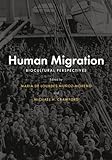Human migration : biocultural perspectives / Maria de Lourdes Muñoz, Michael H. Crawford.
Material type: TextPublisher: New York : Oxford University Press, 2021Description: pages cmContent type: text Media type: unmediated Carrier type: volumeISBN: 9780190945961Summary: "Studies are shown on many aspects of migration, population development, human genetics, archaeology, anthropology, biology, linguistics, and a broad range of genomic studies on migration and cultural and social structures in the past and present. Human migration started in Africa up to Asia and other regions of our globe was assessed by studies on mtDNA sequencing distributed from the artic to South America. The evolutionary consequences of the settlement of the Aleutian Islands indicated the loss of genetic variability stimulated by population fission and founder effect, which was confirmed by data demonstrating the loss of mitochondrial haplogroup "B" in contemporary Aleuts, but present in prehistoric Aleut populations. Regional migrations comprises Samoyedic-speaking populations from Siberia; early human migrations in Gabon Africa, the Republic of Sakha (formerly, Yakutia), African migration to Europe during the twenty-first century, and the Y-chromosome diversity in Aztlan descendants associated with the History of Central Mexico. Human migration influenced by cultural practices was evaluated by biocultural approaches to migration and urbanization in the Peruvian Amazonia, the Ch'orti' Maya Diaspora-- in Search of Fertile Forests and Political Security. Evidence of human migration in the Puyil Cave (Puxcatán, Tabasco), the Maya and Zoques to the Mountain Region of Tabasco (from linguistic and archaeological perspectives) are also considered. It was also document the migration of specific populations in the geographic distribution of diseases such as Dengue, and Mycobacterium. Human Migration: Biocultural Perspective explains human migration as a major contributor to globalization that facilitates gene flow and the exchange of cultures and ideas"-- Provided by publisher.
TextPublisher: New York : Oxford University Press, 2021Description: pages cmContent type: text Media type: unmediated Carrier type: volumeISBN: 9780190945961Summary: "Studies are shown on many aspects of migration, population development, human genetics, archaeology, anthropology, biology, linguistics, and a broad range of genomic studies on migration and cultural and social structures in the past and present. Human migration started in Africa up to Asia and other regions of our globe was assessed by studies on mtDNA sequencing distributed from the artic to South America. The evolutionary consequences of the settlement of the Aleutian Islands indicated the loss of genetic variability stimulated by population fission and founder effect, which was confirmed by data demonstrating the loss of mitochondrial haplogroup "B" in contemporary Aleuts, but present in prehistoric Aleut populations. Regional migrations comprises Samoyedic-speaking populations from Siberia; early human migrations in Gabon Africa, the Republic of Sakha (formerly, Yakutia), African migration to Europe during the twenty-first century, and the Y-chromosome diversity in Aztlan descendants associated with the History of Central Mexico. Human migration influenced by cultural practices was evaluated by biocultural approaches to migration and urbanization in the Peruvian Amazonia, the Ch'orti' Maya Diaspora-- in Search of Fertile Forests and Political Security. Evidence of human migration in the Puyil Cave (Puxcatán, Tabasco), the Maya and Zoques to the Mountain Region of Tabasco (from linguistic and archaeological perspectives) are also considered. It was also document the migration of specific populations in the geographic distribution of diseases such as Dengue, and Mycobacterium. Human Migration: Biocultural Perspective explains human migration as a major contributor to globalization that facilitates gene flow and the exchange of cultures and ideas"-- Provided by publisher.
| Item type | Current library | Call number | Status | Date due | Barcode | Item holds |
|---|---|---|---|---|---|---|
 Kalpataru Collection
Kalpataru Collection
|
Kalpataru : Custom Content Digital Library | Not for loan |
"Studies are shown on many aspects of migration, population development, human genetics, archaeology, anthropology, biology, linguistics, and a broad range of genomic studies on migration and cultural and social structures in the past and present. Human migration started in Africa up to Asia and other regions of our globe was assessed by studies on mtDNA sequencing distributed from the artic to South America. The evolutionary consequences of the settlement of the Aleutian Islands indicated the loss of genetic variability stimulated by population fission and founder effect, which was confirmed by data demonstrating the loss of mitochondrial haplogroup "B" in contemporary Aleuts, but present in prehistoric Aleut populations. Regional migrations comprises Samoyedic-speaking populations from Siberia; early human migrations in Gabon Africa, the Republic of Sakha (formerly, Yakutia), African migration to Europe during the twenty-first century, and the Y-chromosome diversity in Aztlan descendants associated with the History of Central Mexico. Human migration influenced by cultural practices was evaluated by biocultural approaches to migration and urbanization in the Peruvian Amazonia, the Ch'orti' Maya Diaspora-- in Search of Fertile Forests and Political Security. Evidence of human migration in the Puyil Cave (Puxcatán, Tabasco), the Maya and Zoques to the Mountain Region of Tabasco (from linguistic and archaeological perspectives) are also considered. It was also document the migration of specific populations in the geographic distribution of diseases such as Dengue, and Mycobacterium. Human Migration: Biocultural Perspective explains human migration as a major contributor to globalization that facilitates gene flow and the exchange of cultures and ideas"-- Provided by publisher.


There are no comments on this title.